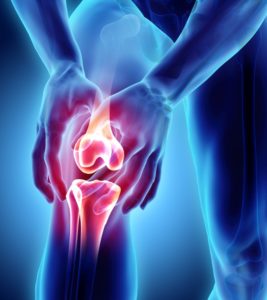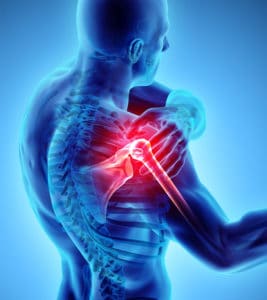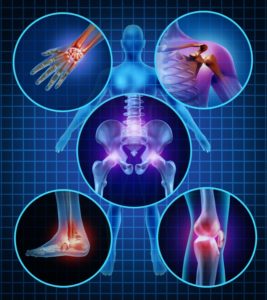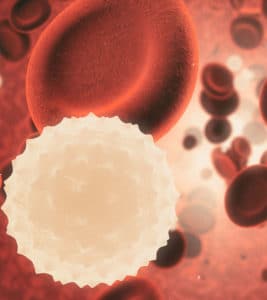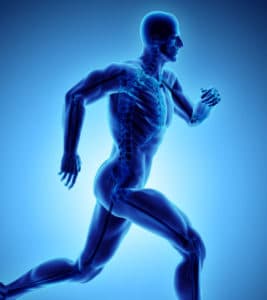Meniscus Tear
The meniscus is a C-shaped piece of tough cartilage located in the knee, that acts as a shock absorber between the shinbone and the thighbone. There are two minisci within each knee. The meniscus on the inside part of the knee is known as the medial meniscus and the meniscus located on the outside of the knee is referred to as the lateral meniscus. A meniscus tear may be the result of an activity that forcefully twists or rotates the knee. A torn meniscus is a common knee injury that may be caused by playing sports, or a traumatic injury, and most frequently occurs when the knee joint is bent and the knee is then twisted. Torn menisci are common in athletes, but in some cases this condition may occur in older adults whose cartilage has worn away, as a result of many years of wear and tear of the joint.
Symptoms Of A Meniscus Tear
Meniscus tears are usually defined by a distinctive popping or clicking sensation when the injury occurs. Most people will still be able to walk or play a sport using their injured knee, but the knee typically becomes swollen and stiff within a few days. The most common symptoms of meniscus tears include:
- Persistent pain whenever the knee is moved or twisted
- Stiffness
- Swelling
- Inability to fully straighten the knee
A torn meniscus may also be accompanied by joint that frequently locks in place and the inability to completely straighten the knee.
Diagnosis Of A Meniscus Tear
A meniscus tear is typically diagnosed after a complete evaluation of the patient’s symptoms is conducted and a medical history obtained. The knee will be examined for tenderness along the joint line, which usually signifies the presence of a meniscus tear.
Several diagnostic tests will generally follow to confirm the tear. One commonly used evaluation tool is the McMurray test, in which the knee is bent, straightened and moved around in a circular fashion by the doctor. The circular motion places added tension on the meniscus and causes an audible clicking sound, enabling the doctor to diagnose the tear. Imaging tests, such as X-rays or an MRI or CT scan, may also be needed to obtain a view of the torn meniscus.
Treatment For A Meniscus Tear
If left untreated, a meniscus tear may result in a portion of the cartilage becoming loose and moving into the joint, causing the knee to slip out of place. Treatment usually depends on the severity of the tear and its exact location. Initial treatment methods for meniscus tears are generally conservative, such as placing ice on the knee, taking anti-inflammatory medications and elevating the knee to reduce swelling.
If symptoms continue despite these conservative measures, surgery may be necessary. Minimally invasive knee arthroscopy is one of the most commonly performed procedures to treat the condition. During this procedure, a flexible tube with a camera known as an arthroscope is inserted into the knee through a small incision. Small surgical instruments will be used to perform either a meniscus repair, which focuses on suturing the torn edges of the meniscus together to promote healing, or a meniscectomy, during which damaged meniscal tissue is trimmed away.
Physical therapy may also be effective at strengthening the muscles that support the knee joint. If these treatments are not effective and symptoms continue, meniscus repair surgery may be recommended. Meniscus repair is an arthroscopic surgery performed by orthopedic surgeons to remove the torn segment of the meniscus. The torn edges are then sutured together, which allows them to heal properly. Recovery from meniscus repair surgery can take several months of immobilization and the use of crutches. A physical therapy program is also effective after surgery to strengthen muscles and help the patient regain full mobility.
Meniscus Tear FAQs
What Is The Meniscus?
The meniscus is a C-shaped piece of tough cartilage located in the knee, that acts as a shock absorber between the shinbone and the thighbone. There are two minisci within each knee. The meniscus on the inside part of the knee is known as the medial meniscus and the meniscus located on the outside of the knee is referred to as the lateral meniscus.
How Does A Meniscus Tear Happen?
A meniscus tear may be the result of an activity that forcefully twists or rotates the knee. A torn meniscus is a common knee injury that may be caused by playing sports, or a traumatic injury, and most frequently occurs when the knee joint is bent and the knee is then twisted. Torn menisci are common in athletes, but in some cases this condition may occur in older adults whose cartilage has worn away, as a result of many years of wear and tear of the joint.
What Are The Symptoms Of A Meniscus Tear?
Most individuals who have torn their meniscus experience a popping or clicking sensation when the injury occurs. Additional symptoms may include pain, swelling and stiffness in the knee. A torn meniscus may also be accompanied by joint that frequently locks in place and the inability to completely straighten the knee.
How Is A Meniscus Tear Treated?
Treatment for a meniscus tear often begins with conservative methods such as rest, ice or over-the-counter pain medication. If these treatments are not effective and symptoms continue, meniscus repair surgery may be recommended.
What Is Meniscus Repair Surgery?
Meniscus repair is an arthroscopic surgery performed by an orthopedic surgeon to remove the torn segment of the meniscus. The torn edges are then sutured together, which allows them to heal properly. Recovery from meniscus repair surgery can take several months of immobilization and the use of crutches. A physical therapy program is also effective after surgery to strengthen muscles and help the patient regain full mobility.
When Would A Person Need A Meniscal Transplant?
When a meniscus is torn due to injury or overuse, it can often be repaired with surgery that involves suturing the damaged ends together. However, in cases where the meniscus is extremely damaged and cannot be repaired, it may need to be removed completely and replaced with donor cartilage. This type of transplant can provide cushioning to the joint and prevent the bones and other structures from rubbing together, alleviating considerable pain.
Who Would Benefit From A Meniscal Transplant?
A meniscal transplant is typically much more successful in a younger, active individual who has damage due to an injury. Candidates for a meniscal transplant may include individuals who are physically fit, have stable knees and do not have arthritis. Older patients, especially those with osteoarthritis, are often better candidates for a joint replacement surgery instead of a meniscal transplant.
What Is The Meniscal Transplant Procedure?
This meniscal transplant is commonly performed as an outpatient procedure. The meniscal transplant procedure is performed arthroscopically, with tiny surgical instruments inserted through very small incisions. The arthoscope is inserted into the knee through a small incision. The meniscus and any remaining tissue are removed from the knee. The donor meniscus is attached to the shinbone and sutured in place. The incision is then closed and bandages are placed over the wound.
Rehabilitation For A Torn Meniscus
A torn meniscus is a common injury of the knee, typically the result of forcefully rotating the knee while it is bearing weight. The meniscus, a piece of cartilage that functions as a shock absorber, can also tear as a result of the degenerative changes that occur during aging. In many cases, a torn meniscus may go undetected, but some patients may experience intense pain with this injury. Although arthroscopic surgery is sometimes necessary to repair the tear, in many cases physical therapy treatments may be all that is needed. If surgery is necessary, postsurgical rehabilitation will be required during recovery.
Nonsurgical Rehabilitation For A Torn Meniscus
If pain from a torn meniscus persists after rest, ice, compression and elevation (RICE), a program of physical therapy is prescribed, usually two to three days a week for at least 6 weeks. Studies have shown that a full program of physical therapy is often as helpful in the long term as surgical intervention in getting a patient with a torn meniscus back to normal. Simple exercises performed under the guidance of a trained professional:
- Help to improve and maintain muscle strength
- Improve balance and flexibility
- Maintain proper leg function
In addition to engaging in a program of therapeutic exercises at a physical rehabilitation center, patients are also given exercises to do at home to reinforce treatment. It is important, however, that patients perform only the recommended exercises and do not overdo the routine since reinjury is a danger. If it seems that physical therapy is not providing sufficient relief, surgery to repair the torn meniscus may be considered.
Rehabilitation After Surgery For A Torn Meniscus
There are three types of surgical procedures that may be performed for a meniscus tear, depending on the patient’s specific situation: a partial meniscectomy, a total meniscectomy, and a meniscal transplant. Whichever operation is performed, physical rehabilitation will be necessary. After surgery, the affected knee will have to be immobilized for several months, but a program of physical therapy will begin as soon as possible.
Postsurgical physical therapy will consist of some combination of the following:
- Exercises for strength, balance and flexibility
- Application of heat to improve circulation
- Application of ice to reduce inflammation
- Hydrotherapy
- Ultrasound
- Active release technique (ART) to improve joint articulation
- Kinesio taping to increase support and reduce swelling
While recovery from meniscal surgery can take several months, the patient should experience much less pain and increased strength and mobility during recovery as a result of physical rehabilitation. Arch supports or orthotics may also be recommended to help support the feet and keep them in a proper position to prevent future injury.
Knee Arthroscopy
Arthroscopy is a minimally invasive procedure that allows doctors to examine tissues inside the knee. During an arthroscopic procedure, a device known as an arthroscope is inserted into a small incision in the knee. Through this tube, a thin fiberoptic light, magnifying lens and tiny video camera are inserted, allowing the doctor to examine the joint in great detail. Arthroscopy may be a diagnostic procedure following a physical examination and imaging tests such as MRI or CT scans or X-rays. It may also be used as a method of treatment to repair small injuries in the knee.
Knee Arthroscopy As Treatment
Relatively minor knee damage is frequently treated using arthroscopic techniques. Most knee damage results from sports injuries or osteoarthritis. During an arthroscopic procedure, the surgeon may be able to treat:
- Loose bone or cartilage
- Meniscal tears
- Torn ligaments
- Synovitis (swelling of the joint lining)
- Misalignment of the patella (knee cap)
- Inflamed tissue
In patients with osteoarthritis of the knee, arthroscopy is also used in the removal of dead tissue, a process known as debridement.
Benefits Of Knee Arthroscopy
Because it is minimally invasive, arthroscopy offers the patient many advantages over traditional, more invasive, surgery. These include:
- No cutting of muscles or tendons
- Smaller incisions
- Less bleeding during surgery
- Less scarring
- Shorter recovery time
- Shorter and more comfortable rehabilitation
Candidates For Knee Arthroscopy
Knee arthroscopy is quickly becoming the ideal procedure for many conditions affecting the knee. Its minimally invasive advantages allow patients to receive fast and simple pain relief, increased range of motion and restored function, while avoiding or delaying the need for joint replacement surgery. Despite its many advantages, arthroscopy is not appropriate for every patient. Some patients, especially those with knee problems that are in difficult-to-see areas, may benefit more from conventional surgery.
The Knee Arthroscopy Procedure
Knee arthroscopy is performed on an outpatient basis under local or general anesthesia, depending on the type and severity of the condition, as well as the patient’s personal preference. During the procedure, the surgeon inserts the arthroscope into the knee through a tiny incision. This instrument is used to identify any damage or abnormalities within the knee, or to confirm the diagnosis of a previous imaging exam.
If damaged areas are detected, they can be repaired during the same procedure by inserting surgical instruments into additional small incisions.
Recovery From Knee Arthroscopy
After a knee arthroscopy , patients often experience swelling and pain for several days. These symptoms can be controlled by the usual home remedies: resting and elevating the leg, applying ice and taking over-the-counter painkillers. Patients are encouraged to get up and walk around as soon as possible after the procedure, although crutches or a cane may be needed for some period of time.
Most patients can usually return to work within a week, but will need to undergo physical therapy in order to restore full range of motion to the joint. Most patients can resume light physical activities after a few weeks, although full recovery from knee arthroscopy may take 12 weeks or longer.
Risks Of Knee Arthroscopy
While knee arthroscopy is considered safe for most patients, there are certain risks associated with any surgical procedure. These risks include: infection, blood clots, accumulation of blood in the knee, nerve damage or adverse reactions to medications or anesthesia. In the great majority of cases, the knee arthroscopy goes smoothly.







